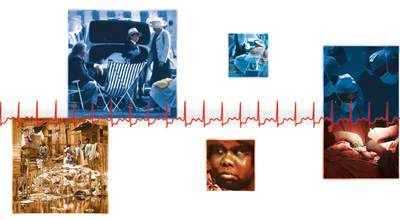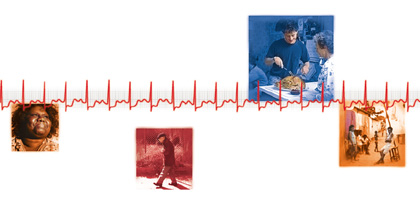Looking at how social
factors affect human health offers proof of conventional
wisdom—and some more surprising insights into disease
and prevention.
“Them
that’s got shall get,”
goes the old Billie Holiday song, challenging the accepted
notion of the United States as an exceptionally mobile society.
“Them that’s not,” the lyrics continue,
“shall lose. So the Bible”—plus, it appears,
mountains of demographic data—“said, and it
still is news.” Also still news is a growing recognition
of the connections between “getting” and “losing”
and health and disease and the relentless discovery of ways
in which deprivation, of any sort, can impair well-being.
Extreme
poverty has long been associated with reduced lifespan,
but now studies are revealing that not just the very
poor—the malnourished or the homeless—but people
in each socioeconomic category have worse health than those
a notch above them. Similar links between resources and
risk have been found in every modern industrial society,
human societies throughout history, and even among nonhuman
primates and other social animals.

Many of these ideas can
be traced to a few pioneers, among them Alvin R. Tarlov,
MD’56. Three decades ago Tarlov—chair of Chicago’s
department of medicine from 1968 to 1985 and now executive
director of the Texas Program for Society and Health, a
consortium based at Rice University—began to study
how health is affected by social factors.
Such study of social determinants
has been slow to take off, however, because the topic is
inherently so wide ranging. Doctors don’t often chat
with economists, who seldom work with sociologists, who
rarely seek out lawyers. So Tarlov protégé
Mark Siegler, MD’67, a physician with a penchant for
ethics, and his Chicago colleague Richard Epstein, a lawyer
with a taste for economics, pulled together a conference
this past November at the Law School—“Social
Determinants of Health and Disease: Recognizing the Contributions
of Dr. Alvin R. Tarlov.”
Practitioners of the social-determinants
approach vary widely but agree that those concerned with
public health should no longer focus simply on biology,
on germs and genes, but should shift more attention to such
variables as financial resources and social status, cognitive
skills and educational background, racial attitudes and
ethnic practices, personal behavior and lifestyle, even
a person’s neighborhood and friends.
A
key factor in the growth of modern industrialized
societies is also a fundamental component of good health:
“physiological capital,” or the accumulation
of health resources. In 1750, noted Robert W. Fogel, a Chicago
Nobel laureate who applies the tools of economics to historical
problems, one-fifth of the English population was kept out
of the labor force because of poor health, largely chronic
malnutrition. These down-and-outs were smaller, frailer,
sicker, and died younger than working people. Since about
1800, however, increased access to food has meant a dramatic
improvement in public health—from 1750 to 1975 the
average Englishman’s body size increased by nearly
50 percent—and a more capable workforce.
Particularly important were
the improved well-being and nutrition of pregnant women.
Well-fed moms gave birth to bigger, healthier children.
This initial investment, Fogel explained, “reduced
the rate of depreciation,” meaning that newborns who
acquired more health resources early in life could fight
off the diseases of old age longer. The result was a kind
of “biological but not genetic evolution,” survival
not quite of the fattest but of those with a sufficient
nest egg of calories.
One good measure of this
progress is the decline in infant mortality. In 1800 some
17 percent of English children died in infancy and a whopping
79 percent of the children born to poor mothers weighed
less than five pounds. Today England’s infant mortality
has fallen to less than 1 percent, and fewer than 8 percent
of newborns weigh under five pounds.
While some may explain these
health-status improvements by citing better medical care,
Fogel attributed them to better nutrition and an improved
environment. Physician intervention could “slow the
rate of depreciation of physiological capital,” he
admitted, but the real gains in public health came from
better diets, access to clean water, and better sanitation,
which have delayed the onset of the chronic diseases of
aging by five to ten years. As for exact figures on the
salutary role of the environment versus health care, Fogel
was “in the middle of applying for a grant”
to determine precisely that.
Yet it isn’t only
the impoverished whose health is affected by socioeconomic
status. While Fogel has focused on the English poor, Sir
Michael Marmot, director of the Whitehall I and II studies
of civil servants, researches the British middle class.
These long-term studies—the first, which began in
1967 and followed participants for 25 years, and Whitehall
II, which began in 1985 and is still under way—have
shown, said Marmot, head of epidemiology and public health
at University College, London, that the social gradient
in health extends from the bottom to the top of society.
Among civil servants, “none of whom is poor,”
the first study found that the least well off had mortality
rates nearly eight times as high as the wealthiest. More
important, there was a significant gap between each step
in the hierarchy. In other words, “The problem is
not confined to the high risk at the bottom.”
Nor is the problem purely
economic. In the United States, Marmot added, 77 percent
of whites live to at least age 65, but only 61 percent of
blacks live that long. Even more revealing, 65 percent of
poor whites live to 65 but only 30 percent of poor blacks
do.
What causes such discrepancies?
Is it access to health care? No, Marmot said. Is it genetics—do
better genes lead to better health and higher socioeconomic
status? No. Is it primarily income, which is closely tied
to education? Again, no, Marmot answered. On an international
scale U.S. blacks are far from poor, yet their life expectancy
is comparable to the residents of Kazakhstan, where income
is measured in goats. More significant than actual income
is relative deprivation—where one lies in the local
hierarchy, a notion that applies not simply to finances
but also to power and independence at work, levels of social
participation, education, and early life experiences, all
of which can influence behaviors, such as smoking and drinking,
that have a health impact. “Control over life,”
he said, “and opportunities to participate fully in
society are powerful determinants of health.”
Yet despair, emphasized
Marmot, “is not warranted. Health for everyone can
improve.” Lifespan and well-being for all social classes
rose dramatically during the 20th century, and the “gap
between rich and poor, between top and bottom, can change.
The slope of the social gradient in mortality is not fixed.”
Where
you find yourself in the social hierarchy may not
be as important as who’s there with you. Arguing for
the need to integrate sexuality into considerations of social
factors affecting health and medicine was Chicago sociologist
Edward O. Laumann, the world’s authority on sexual
practices. His large-scale surveys of sexual behavior in
the United States, and more recently around the world, have
found high rates of sexual dysfunction in all 32 countries
studied, with about 40 percent of women and 30 percent of
men acknowledging sexual problems. “Is that a medical
problem?” he asked. “Or is it inherent in the
nature of sexual expression? Are there too many other things
vying for our attention?”
In contrast sexually transmitted
diseases are a crucial part of human health status and can
only be understood in a sociocultural context. At first
glance, Laumann said, it appears that STDs, like many health
problems, are concentrated among the disadvantaged, with
the highest documented rates found among inner-city African
Americans. But that could be a function of reporting: the
poor go to public clinics that notify the authorities, while
the wealthy choose private physicians who are more discreet.
Indeed, Laumann’s
recent research in China found just the opposite. The sexual
revolution that swept the United States in the 1960s has
had different effects behind the Great Wall. More than 80
percent of Chinese women, and 60 percent of men, have had
only one sexual partner. Although few poor women catch sexually
transmitted diseases, 38 percent of the wealthiest Chinese
women have had chlamydia. What makes this infection so elitist?
It turns out that the use of prostitutes is more socially
acceptable in China, but costly. So wealthy men visit commercial
sex workers, then bring the disease home to their wives.
Cutting across economic
lines are social isolation and loneliness, factors that
Chicago psychologist John T. Cacioppo called key determinants
of health. In all age groups, he has found, loneliness predicts
mortality, with increased rates of cardiovascular disease,
stroke, and cancer occurring in those who are socially isolated.
Efforts to intervene, such as providing short-term social
supports for people recovering from a heart attack, have
been “mostly unsuccessful,” largely because
“we don’t understand the process” that
creates such isolation: “There’s no particular
pathophysiology.”
Nor are there obvious differences
between the lonely and the non-lonely. They look the same.
Their personalities are similar. They face the same difficulties
in life. But lonely people, Cacioppo’s research has
found, don’t cope as well with stressful events; they
tend to withdraw rather than confront problems, perhaps
because they have fewer opportunities to share their successes
and frustrations or conspire with colleagues. Hit harder
by stress, as they age the lonely develop more peripheral
resistance—a sort of vascular teeth clenching—which
reduces cardiac output, increasing the demands on the heart.
They also have higher levels of the hormones associated
with chronic stress. And they complain about sleeping poorly,
a problem confirmed by studies reporting more microawakenings
among lonely sleepers. An estimated 31 million people, most
65 or older, will be living alone by the year 2020. Cacioppo
urged, “We need to find ways to support these people”.

Sociologist Robert J. Sampson,
who recently left the University to take a post at Harvard,
pushed the scope out beyond the individual to look at the
health-related effects of neighborhoods. Since the 1920s
poor, inner-city neighborhoods have been known as “hot
spots” for unhealthy statistics: higher rates of violent
crimes, child abuse, infant mortality, suicide, and accidental
injuries. Clustering people by class, race, and health,
Sampson noted, “is a robust and apparently increasing
occurrence.”
But Sampson and colleagues
have begun to uncover factors that can improve the health
of even poor city neighborhoods. The Project on Human Development
in Chicago Neighborhoods is a massive effort to assess community
ecologies, a process the researchers have dubbed “ecometrics.”
The project team began by dividing the city into 343 neighborhood
clusters, each relatively homogenous in racial or ethnic
mix, socioeconomic status, population density, and family
structure. Then the researchers interviewed 8,782 residents
and 2,900 business, law-enforcement, educational, religious,
political, and community-organization leaders. They also
videotaped 28,000 “micro-community environments”
(such as street blocks) looking for health risks such as
garbage in the streets, public intoxication, or unsafe housing.
They found several traits
linked to better community health. Most important is what
sociologists call “collective efficacy”—residents’
willingness to work together to solve a neighborhood problem.
How eager, the researchers asked, are community members
to step in if children are skipping school and hanging out
on a streetcorner, or spray-painting graffiti on buildings?
It turns out that higher levels of collective efficacy are
associated with lower rates of current and future violence:
“Social ties create the capacity for informal social
control.” Just being next to a neighborhood with high
collective efficacy, Sampson said, “is one of the
best predictors of lower homicide” rates.
That statistic bolsters
his overarching contention that “community-level prevention
that attempts to change social environments” may prove
an effective complement to traditional thinking about disease
and its “individual and disease-specific approach.”
>>
next page


![]() Advertising
Advertising
![]() About
the Magazine
About
the Magazine ![]() Alumni
Alumni
![]() UChicago
UChicago
![]()
![]() ©2003 The University
of Chicago® Magazine
©2003 The University
of Chicago® Magazine ![]() 5801 South Ellis Ave., Chicago, IL 60637
5801 South Ellis Ave., Chicago, IL 60637![]() fax: 773/702-0495
fax: 773/702-0495 ![]() uchicago-magazine@uchicago.edu
uchicago-magazine@uchicago.edu
